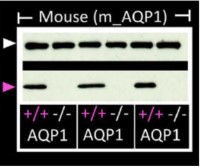Overview
- Peptide (C)KVWTSGQVEEYDLDADDIN corresponding to amino acid residues 242-260 of human AQP1 (Accession P29972). Intracellular, C-terminus.
- Rat kidney membranes (1:400-1:800).
 Western blot analysis of rat kidney membranes:1. Anti-Aquaporin 1 Antibody (AQP-001), (1:400).
Western blot analysis of rat kidney membranes:1. Anti-Aquaporin 1 Antibody (AQP-001), (1:400).
2. Anti-Aquaporin 1 Antibody, preincubated with Aquaporin 1 Blocking Peptide (#BLP-QP001).
- Rat kidney sections (1:100).
Mouse paraffin-embedded kidney sections (1:100) (Kim, J.I. et al. (2013) Am. J. Physiol. 304, F1283.).
Aquaporin 1 (AQP-1) belongs to a family of membrane proteins that allow passage of water and certain other solutes through biological membranes. The family is composed of 13 members (AQP-0 to AQP-12).
The aquaporins can be divided into two functional groups based on their permability characteristics: the aquaporins that are only permeated by water and the aquaglyceroporins that are permeated by water and other small solutes such as glycerol. AQP-1 together with AQP-2, AQP-4 and AQP-5 belongs to the first group1.
Little is known about the function of the two newest members, AQP-11 and AQP-12.
The proteins present a conserved structure of six transmembrane domains with intracellular N- and C-termini. The functional channel is a tetramer but each subunit has a separate pore and therefore the functional channel unit, contains four pores1.
AQP-1 is widely expressed in several organs with prominent expression found in kidney, lung, red blood cells intestine and brain. Studies with mice lacking AQP-1 show that the channel has a critical role in urine concentration2. In addition, AQP-1 expression in tumor cells was shown to contribute to enhanced tumor spread and metastatic potential3.
Application key:
Species reactivity key:

Knockout validation of Anti-Aquaporin 1 Antibody in mouse platelets.Western blot analysis of mouse platelets lysates using Anti-Aquaporin 1 Antibody (#AQP-001) (lower panel). AQP1 immunodetection is observe in platelets from wild type mice (+/+) but absent in platelets from AQP1-/- mice (-/-). GAPDH (upper panel) is used as the loading control.Adapted from Agbani, E.O. et al. (2018) JCI Insight 3, e99062. with permission of the American Society for Clinical Investigation.
